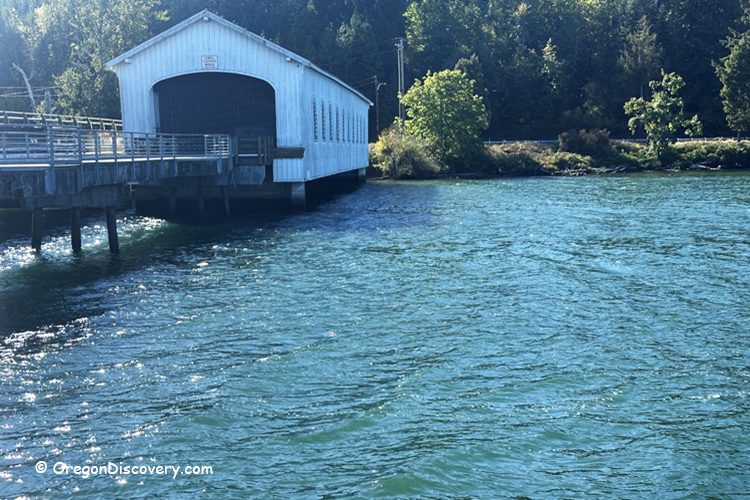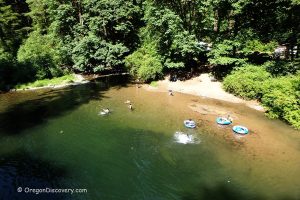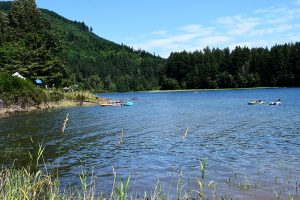
• Lowell Covered Bridge is the widest covered bridge in Oregon
• The bridge was raised 6 feet to prevent it from flooding
The Lowell Covered Bridge, located just a short drive from Eugene near the town of Lowell, stands as a picturesque landmark over the tranquil waters of Dexter Reservoir, adjacent to the modern Pioneer Street Bridge. More than a pedestrian crossing, it now serves as the Lowell Covered Bridge Interpretive Center, celebrating the history of covered bridges in Lane County.
Visitors can explore engaging indoor and outdoor exhibits and enjoy picnic areas, restrooms, and scenic views across the reservoir—making it a perfect stop for nature lovers and history enthusiasts.
The bridge features a distinctive Howe truss design, wide rounded portals, and bright white siding. At 165 feet (50 m) long and 24 feet (7 m) wide, it holds the title of Oregon’s widest covered bridge.

Lowell Covered Bridge History
The story of the Lowell Covered Bridge begins in the late 19th century, when pioneer Amos Hyland settled along the Middle Fork Willamette River and founded the town of Lowell, named after his birthplace in Maine.
Hyland operated a ferry service to help settlers and supplies cross the river, but a permanent bridge soon became necessary.
In 1907, county contractor Nels Roney and his crew of eight men built the original bridge, designed to handle horse-drawn wagons. As heavier truck traffic arrived, the structure deteriorated.
In 1945, a truck damaged the bridge truss, prompting the county to replace it with a sturdier version. Designed by Walt Sorensen, Lane County’s bridge foreman, the new structure was completed in 1947 and covered soon after to protect it from the elements.

In 1953, engineers raised the bridge six feet to prepare for the rising waters of Dexter Dam. Decades later, recognizing its cultural importance, the bridge was added to the National Register of Historic Places in 1979.
A modern concrete bridge was built beside it in 1981, but before construction was completed, a dump truck with its bed raised struck the covered bridge, damaging the roof braces and portals. After repairs, the bridge stood unused until the Oregon Department of Transportation undertook a full restoration.
Finished in 2006 at a cost of $1.2 million, the project preserved the bridge as both a historic structure and an interpretive center open to visitors today.

Why is this bridge so special?
Historic Significance: Built in 1907 and rebuilt in 1945, the Lowell Covered Bridge is the last of several historic spans over the Middle Fork Willamette River and highlights Lane County’s covered bridge heritage.
Unique Design: At 165 feet, it’s the widest covered bridge in Oregon, featuring broad portals, white board-and-batten siding, and a Howe truss structure.
Scenic & Educational Link: No longer open to vehicles, the bridge serves as an interpretive landmark and scenic stop, with easy access from Highway 58 for travelers exploring Dexter Lake and the Willamette Valley.
Lowell Covered Bridge | Facts
Architectural Bridge Design: Howe truss
Bridge access: Pedestrian
Stream: Middle Fork Willamette River, Dexter Reservoir
Bridge Length: 165 ft (50 m)
Built: 1907
Rebuilt: 1945
Reopened: 2006
Open: Year-round
Elevation: 722 ft (220 m)
Lowell Covered Bridge is located:
- 21 miles southeast of Eugene
- 82 miles southeast of Salem
- 126 miles south of Portland.
Adventures Nearby
Directions to Lowell Covered Bridge
- Take I-5 South
- Take exit 188 toward OR-58
- Take the OR-58 exit toward Oakridge/Klamath Falls
- Continue onto OR-58 for 13.1 miles.








